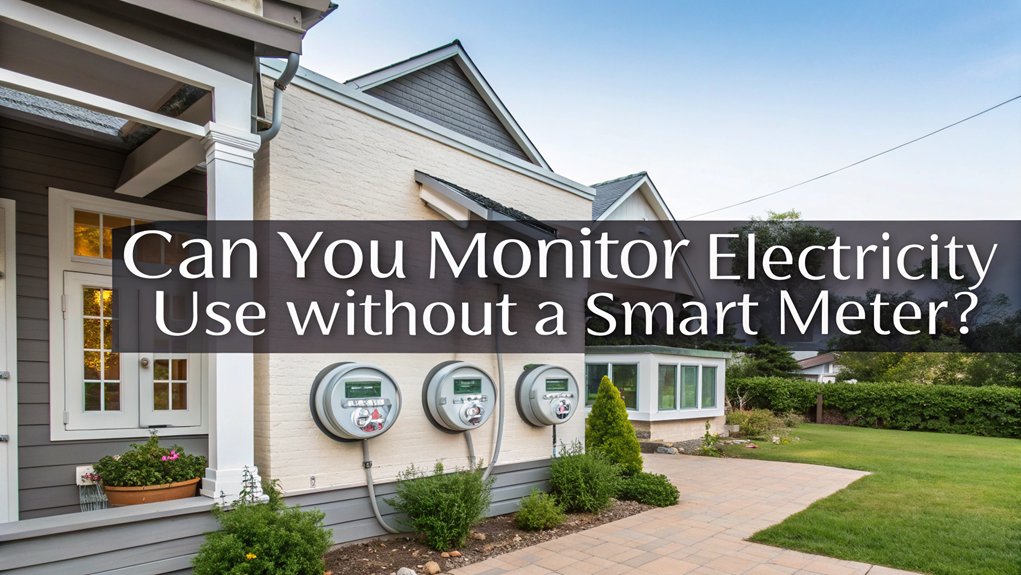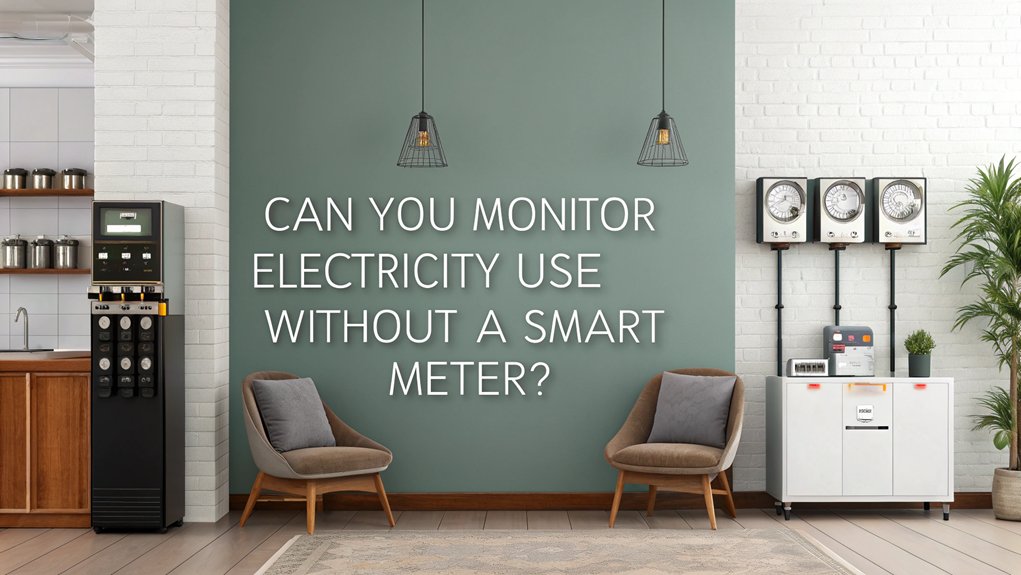You can monitor electricity use without a smart meter by analyzing traditional and digital meters, which display kilowatt-hour readings for manual tracking. Implement whole-home monitors for real-time insights and use appliance meters to pinpoint energy-hogging devices. Focus on electric showers, washing machines, and refrigerators—known for high consumption. Shift to LED lighting for significant savings. Explore bills to uncover usage trends, and actively reduce phantom power. Want to uncover more effective strategies?
Key Facts Summarized
- Use traditional analog or digital meters for monthly manual electricity consumption tracking.
- Whole-home energy monitors provide real-time insights without needing a smart meter.
- Appliance meters track specific devices’ energy use and help identify inefficient appliances.
- Load disaggregation technology monitors usage across individual circuits for detailed analysis.
- Behavioral adjustments based on consumption patterns can reduce electricity bills significantly.
Understanding Traditional Meters
Traditional meters, whether analog or digital, play an essential role in measuring your household’s electricity consumption. They track energy usage over time in kilowatt-hours (kWh).
Analog meters use a rotating disk, where the speed of the spin indicates current electricity use—a faster spin means higher consumption. Digital meters, on the other hand, display kWh directly, making it easier to record numbers.
To monitor electricity, you need to manually record the readings monthly. By noting initial and final readings weekly, you can calculate your energy usage and accordingly manage your energy bills better. Additionally, regularly reading the meter and comparing monthly usage can help identify patterns and anomalies in your consumption.
Be aware that traditional meters might lead to estimated billing based on previous patterns, potentially causing bill inaccuracies unless you regularly track and verify your consumption.
Exploring Whole-Home Energy Monitors
While smart meters aren’t an option for everyone, whole-home energy monitors present an innovative alternative for gaining real-time insights into your electricity usage. By employing load disaggregation technology, these devices track consumption across individual circuits, pinpointing energy hogs.
Here’s how they can help you reduce your electricity consumption:
- Data-driven Insights: Whole-home monitoring provides detailed reports on your energy consumption patterns, helping you identify areas for improvement.
- Behavioral Changes: Users report average savings of nearly 10% on power bills, with some achieving up to 20% by adjusting habits.
- Technology Options: Models like the Sense Energy Monitor offer machine learning insights, while Emporia Energy focuses on user-friendly app integration.
- Engagement Required: Active tracking and behavioral adjustments are essential to maximize savings, as monitors don’t automatically reduce bills. Additionally, identifying high-energy devices through these monitors can lead to more informed decisions and further reduce consumption.
Utilizing Appliance Meters for Targeted Monitoring
Even without a smart meter, you can effectively monitor your electricity usage by utilizing appliance meters for targeted monitoring. These devices provide real-time data on energy consumption, allowing you to track the power draw of specific appliances. By displaying estimated operating costs, appliance meters help you identify inefficient appliances and encourage energy-saving habits. Priced between £30-£45, they’re an affordable tool for reducing electricity bills and achieving potential savings. Additionally, monitoring capabilities can help you manage vampire appliances, which account for about 10% of energy bills.
| Feature | Benefit |
|---|---|
| Real-time data | Immediate insights on usage |
| Cost estimation | Identify and cut high expenses |
| Fault detection | Spot and fix energy waste |
Seeing the immediate impact of your decisions can lead to more conscious energy consumption and help maintain efficient household operations.
Identifying High-Energy Consumption Devices
Many households unknowingly harbor high-energy consumption devices that considerably impact electricity bills.
By monitoring electricity use, you can identify which devices are the culprits. Here are some common high-energy devices you should watch:
- Electric Showers: These can draw a significant amount of energy, especially with frequent use.
- Hair Dryers: Although used for short periods, their high power ratings contribute to electricity use.
- Washing Machines: They’re notable for high energy consumption, particularly on hot wash cycles.
- Refrigerators: Continuous operation makes them one of the biggest energy users.
To pinpoint high-energy devices, regularly check your electrical meter readings. Circuit-level monitoring can provide detailed insights into individual device consumption, helping you understand their impact on your energy bills.
Appliance meters offer precise monitoring of individual device consumption, helping you understand their impact on your energy bills.
Implementing Energy-Efficient Lighting Solutions
After identifying the high-energy devices in your home, it’s important to focus on lighting, a significant area where energy efficiency can be improved. Switching to energy-efficient lighting options like Compact Fluorescent Lamps (CFLs) and LED bulbs can substantially reduce electricity usage. CFLs use about 75% less energy, while LED bulbs cut down usage by up to 90% compared to incandescent bulbs, translating into significant savings.
| Benefit | Impact |
|---|---|
| Energy Savings | Save $100+ annually |
| Reduced Carbon Footprint | Promotes environmental sustainability |
| Smart Lighting Options | Motion sensors, dimmer switches |
Incorporate smart lighting solutions with monitoring systems to further optimize energy use. These smart systems adapt to your daily habits, ensuring lights are on only when needed, maximizing savings and efficiency.
Addressing Phantom Power Consumption
While it might seem negligible, phantom power consumption can considerably impact your electricity bill. Accounting for 5-10% of your household’s energy use, devices like computers and kitchen appliances still draw power even when turned off.
To effectively save on energy, consider these strategic actions:
- Identify Culprits: Use home energy monitoring to pinpoint devices contributing most to phantom power.
- Use Smart Power Strips: These automatically cut power to peripherals when the main device is off, reducing unnecessary energy draw.
- Install Timed Power Strips: Program them to cut power during non-use hours, minimizing waste.
- Educate Household Members: Awareness of phantom power can encourage everyone to unplug unused devices.
Additionally, electricity usage monitors can help identify silent power drainers that may contribute to your overall energy costs.
Adopting these measures helps cut power usage and reduce your electricity bill.
Leveraging Smart Plugs and Timers
As you look to optimize your household’s energy efficiency, leveraging smart plugs and timers presents a practical and insightful approach.
Smart plugs allow you to control and monitor electricity use of individual devices remotely. With energy monitoring features, these devices display real-time power draw in watts and track cumulative usage, offering insights into operational costs. This data helps you identify energy-hogging appliances, enabling informed decisions about usage patterns and potential replacements.
Timer switches further enhance efficiency by automating power delivery, allowing you to schedule operations during off-peak hours, reducing energy costs.
With prices ranging from £20 to £50, smart plugs are a cost-effective solution for monitoring electricity use, providing a clear view of your household’s energy dynamics without needing a smart meter.
Analyzing Electricity Bills for Usage Patterns
Even without a smart meter, you can glean valuable insights into your household’s energy consumption by diligently analyzing your electricity bills.
By focusing on the kilowatt-hours (kWh) used, you’ll identify patterns in your usage, pinpointing high-consumption periods that may need attention.
To effectively monitor and analyze your bills, consider the following steps:
- Track Monthly Consumption: Review your electricity bill to note the total kWh used each month. This highlights trends and potential spikes.
- Compare Cost Per kWh: Understanding how much you’re charged per kWh informs any cost-saving strategies you might implement.
- Spot High-Usage Factors: Identify specific appliances or activities contributing to increased consumption.
- Monitor Changes Over Time: Regularly check your bills to understand how consumption patterns evolve, helping you make informed energy decisions. Additionally, tracking your usage can help you identify usage patterns that contribute to energy efficiency and sustainability efforts.
Reducing Energy Consumption With Behavioral Changes
Understanding and reducing your energy consumption can lead to significant savings on your electricity bills.
Begin by monitoring electricity usage with your traditional meter to identify consumption patterns. Implementing behavioral changes is essential. Unplugging phantom power devices when not in use reduces wastage, as these devices draw power continuously.
Switching to energy-efficient light bulbs can lower the energy you use for lighting by up to 80%. Wash clothes at 30 degrees; heating water accounts for most energy in laundry.
Opt for gas heating over electric showers to slash high energy consumption, particularly in homes with frequent users. Finally, air-dry laundry instead of tumble drying to further cut down on energy usage.
These small changes collectively contribute to reducing energy consumption effectively.
Frequently Asked Questions
How Can I Monitor My Own Electricity Usage?
You can monitor your electricity usage by manually reading your electric meter weekly to calculate kilowatt-hour (kWh) consumption.
Use appliance meters to measure individual device usage by plugging them into the meter.
Employ energy monitoring devices like clip-on sensors for real-time data.
Analyze your electricity bills, focusing on kilowatt usage patterns.
Adopt energy-saving practices, such as using low-energy bulbs, to reduce consumption without smart meter dependency.
How Can I Track My Daily Electricity Usage?
Imagine electricity as a flowing river; you’re the vigilant fisherman.
Start by checking your meter each morning and evening, reeling in data on kilowatt-hours used.
Plug appliance meters into devices to uncover energy-hungry culprits.
Examine your bill for patterns and use clip-on sensors for precise tracking.
How to Monitor Electricity Usage Remotely?
To monitor electricity usage remotely, use appliance meters for real-time data by plugging them into your outlets.
Consider energy monitors costing £30-£45 for overall tracking. Opt for devices with smartphone app integration for notifications on high usage.
Utilize clip-on or light-flashing detectors to identify consumption at the circuit level.
For a more manual approach, regularly read your traditional meter to analyze patterns and target areas for energy reduction.
Is There a Device to Monitor Electricity Usage?
Yes, you can monitor electricity usage with energy monitors.
These devices, efficient and precise, clip-on sensors and plug-in meters, track power consumption without needing a smart meter. Typically priced between £30 and £45, they provide real-time data, helping you identify high-energy devices.
Some offer remote displays, making monitoring convenient. By analyzing consumption patterns, you can pinpoint inefficiencies and reduce costs, leading to substantial savings on your electricity bills over time.
Conclusion
By embracing strategies akin to Sherlock Holmes’ deductive methods, you can effectively monitor electricity without a smart meter. Explore the data from traditional meters, and employ whole-home and appliance monitors to unearth high-energy culprits. Address phantom power and optimize with smart plugs. Scrutinize your electricity bills to discern patterns and make behavioral adjustments. With these analytical approaches, you’ll unravel your energy consumption mysteries and pave the way to a more efficient household.

